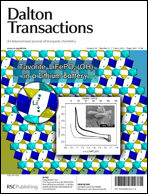We describe the preparation, the crystal structure refined from neutron powder diffraction (NPD) data, and study of the permittivity of two related double perovskites, Pb2Sc(Ti0.5Te0.5)O6 and Pb2Sc(Sc0.33Te0.66)O6. These compounds were synthesized by standard ceramic procedures; Rietveld refinements from room temperature NPD data show that the crystal structures are well defined in a cubic unit cell (space group Fm![[3 with combining macron]](https://www.rsc.org/images/entities/char_0033_0304.gif) m) with double parameter, a = 2a0≈ 8 Å. They contain a completely ordered array of ScO6 and (B,Te)O6 (B = Sc, Ti) octahedra sharing corners; the PbO12 polyhedra present an off-center displacement of the lead atoms along the [1 1 1] directions, due to the electrostatic repulsion between the Pb2+ 6 s electron lone-pair and the Pb–O bonds of the cuboctahedron. Both compounds present a low temperature, highly dispersive maximum in permittivity, the position of which follows the Vogel–Fulcher relation with freezing temperatures of 156 and 99 K for Pb2Sc(Ti0.5Te0.5)O6 and Pb2Sc(Sc0.33Te0.66)O6, respectively, exhibiting a typical phenomenology of relaxors.
m) with double parameter, a = 2a0≈ 8 Å. They contain a completely ordered array of ScO6 and (B,Te)O6 (B = Sc, Ti) octahedra sharing corners; the PbO12 polyhedra present an off-center displacement of the lead atoms along the [1 1 1] directions, due to the electrostatic repulsion between the Pb2+ 6 s electron lone-pair and the Pb–O bonds of the cuboctahedron. Both compounds present a low temperature, highly dispersive maximum in permittivity, the position of which follows the Vogel–Fulcher relation with freezing temperatures of 156 and 99 K for Pb2Sc(Ti0.5Te0.5)O6 and Pb2Sc(Sc0.33Te0.66)O6, respectively, exhibiting a typical phenomenology of relaxors.

You have access to this article
 Please wait while we load your content...
Something went wrong. Try again?
Please wait while we load your content...
Something went wrong. Try again?
![[3 with combining macron]](https://www.rsc.org/images/entities/char_0033_0304.gif) m
m

 Please wait while we load your content...
Please wait while we load your content...